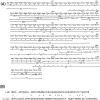Initial studies of the cytoplasmic FABP superfamily
- PMID: 20228622
- PMCID: PMC3417847
- DOI: 10.2183/pjab.86.220
Initial studies of the cytoplasmic FABP superfamily
Abstract
Our colleagues and we have determined the complete primary structure of a low molecular weight cytoplasmic FABP (also known as z-protein) that binds to LCFAs with high affinities, obtained from rat liver. At the same time, we were the first to propose that rat FABP1, bovine FABP8 (MP-2), bovine CRBP and rat CRABP constituted a protein superfamily in 1982. Since then, extensive investigation of structures, functions and expressions has been carried out on a whole family of FABPs. Analyses of rat heart FABP; FABP1, FABP3 and alpha(2U)-globulin expressed in rat kidney; discovery of ileal FABP6 (I-15P); and first application of FABP2 as a diagnostic marker also stand out in particular.
Figures






References
-
- Takahashi K., Odani S., Ono T. (1982) Primary structure of rat liver z-protein. A low-Mr cytosol protein that binds sterols, fatty acids and other small molecules. FEBS Lett. 140, 63–66 - PubMed
-
- Takahashi K., Odani S., Ono T. (1982) A close structural relationship of rat liver z-protein to cellular retinoid binding proteins and peripheral nerve myelin P2 protein. Biochem. Biophys. Res. Commun. 106, 1099–1105 - PubMed
-
- Hertzel A.V., Bernlohr D.A. (2000) The mammalian fatty acid-binding protein multigene family: Molecular and genetic insights into function. TEM. 11, 175–180 - PubMed
-
- Chmurzynska A. (2006) The multigene family of fatty acid-binding proteins (FABPs): Function, structure and polymorphism. J. Appl. Genet. 47, 39–48 - PubMed
-
- Liu R.Z., Li X., Godbout R. (2008) A novel fatty acid-binding protein (FABP) gene resulting from tandem gene duplication in mammals: transcription in rat retina and testis. Genomics 92, 436–445 - PubMed
Publication types
MeSH terms
Substances
LinkOut - more resources
Full Text Sources
Research Materials
Miscellaneous

